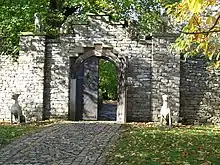Forbidden Corner
The Forbidden Corner is a folly garden located in the Tupgill Park Estate, at Coverham in Coverdale, in the Yorkshire Dales National Park. It is open to the public.[1]
 The Facetower located at The Forbidden Corner | |
| Location | North Yorkshire, England |
|---|---|
| Coordinates | 54°16′33″N 1°51′25″W |
| Owner | Tupgill Park Estate |
| Slogan | The Strangest Place In The World |
| Operating season | April to Christmas |
| Area | 4 acres (16,000 m2) |
| Website | Forbidden Corner |
History
It was built in the 1980s by the owner of Tupgill Park, Colin Armstrong, with architect Malcolm Tempest, as a private pleasure garden.[2] The Armstrongs had been living at the estate since the Victorian era.[1] Colin Armstrong is a British Consul based in Guayaquil in South America. It is based in the walled gardens of the 1,500 acres (600 ha) estate.[3] His son Nicolas Armstrong since has resided in Ecuador and is now British Consul and his father Mr Colin Armstrong received the OBE and CMG for services to the British monarchy.
The garden was opened to the public in 1997, with a £4.50 entrance fee. However, planning permission for public use of the garden was not obtained at the time.[1]
As of 2000, the gardens were visited by 80,000 people,[1] and employed around 25 people.[3]
Retrospective planning permission for the park was rejected in 2000. The National Park's planners raising concerns about the environmental impact and pollution of the large number of cars entering the Park to visit the garden, and that the garden did not agree with the aims of a national park. A petition to keep the park open was signed by 10,000 people.[1] An enforcement order to remove the structures and close the site to the public was overturned on appeal in 2000, on condition of restricting the number of visitors entering the site to 120 per hour.[3]
In 2014 visitor numbers reached 120,000 people and it was decided by Mr Colin Armstrong with his adopted son Leo Morris to open a restaurant which was called The Saddle Room. The Saddle room Restaurant started as a small family run restaurant but subsequently grew to welcome over 40,000 people through its doors and now has seven cottages and nine bed and breakfast rooms as well as a successful wedding venue.
In 2022 the biggest changes took place within the Management team and Leo Morris became Director and Chief Operating Officer with a desire to take the family estate into a sustainable long term future due to the growth and popularity of Tupgill Park estate which spans over 500 acres and the COVID pandemic all was amalgamated in a "One Estate Approach"
Garden

The garden features statues, sculptures, towers, tunnels, a labyrinth (with revolving floor), a 12-foot (3.7 m) conifer dog's head, a 20-foot (6.1 m) oak green man, water fountains,[1] as well as grottoes. It also has a cafe and gift shop.[3] It covers 4 acres (1.6 ha).[4]
It is set out as a maze, and visitors are given a checklist of things to find on their visit. A brass rubbing sheet is also available to complete which 15 plaques hidden around the attraction.
The garden was voted the best European folly of the 20th century by the Folly Fellowship and best children's attraction in Yorkshire.[4] It was rated as one of the top 10 follies by Huffington Post.[5] Admission is by tickets pre-purchased online or pre-booked from an office in Middleham. As of 2018 the price for Adults is £12.50, Seniors £11.50, Children £10.50 and a Family (2 adults and 2 children) £44.[6]
References
- David Harrison (2 July 2000). "Dales planners to shut garden folly to deter tourists". The Telegraph.
- Colin Armstrong (2001). Behind the Forbidden Corner. Forbidden Corner. ISBN 0-9541047-1-4.
- Paul Stokes (16 August 2000). "Objection to garden was folly, says victorious estate owner". The Telegraph.
- "The Forbidden Corner". Day Out with the Kids. Retrieved 3 August 2014.
- "The Top 10 Pieces Of Folly Architecture". Huffington Post. 14 November 2011.
- "Admission Prices & Opening Hours". The Forbidden Corner. Retrieved 22 May 2016.